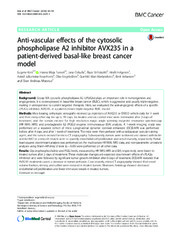Browsing Artikler, rapporter og annet (farmasi) by Author "Engebråten, Olav"
-
Anti-vascular effects of the cytosolic phospholipase A2 inhibitor AVX235 in a patient-derived basal-like breast cancer model
Kim, Eugene; Tunset, Hanna Maja; Cebulla, Jana; Vettukattil, Muhammad Riyas; Helgesen, Heidi; Feuerherm, Astrid Jullumstrø; Engebråten, Olav; Mælandsmo, Gunhild; Johansen, Berit; Moestue, Siver Andreas (Journal article; Tidsskriftartikkel; Peer reviewed, 2016-03-07)<b>Background</b> <br> Group IVA cytosolic phospholipase A2 (cPLA2α) plays an important role in tumorigenesis and angiogenesis. It is overexpressed in basal-like breast cancer (BLBC), which is aggressive and usually triple-negative, making it unresponsive to current targeted therapies. Here, we evaluated the anti-angiogenic effects of a specific cPLA2α inhibitor, AVX235, in a patient-derived ... -
Ceramide-containing liposomes with doxorubicin: time and cell-dependent effect of C6 and C12 ceramide
Øverbye, Anders; Holsæter, Ann Mari; Fusser, Markus; Skalko-Basnet, Natasa; Iversen, Tore Geir; Torgersen, Maria Lyngaas; Sønstevold, Tonje; Engebråten, Olav; Flatmark, Kjersti; Mælandsmo, Gunhild; Skotland, Tore; Sandvig, Kirsten (Journal article; Tidsskriftartikkel; Peer reviewed, 2017-08-12)Doxorubicin, a widely used chemotherapeutic drug, has several potential high- risk side effects including cardiomyopathy. Furthermore, cellular resistance to this drug develops with time. By using liposomes as carrier vesicles both the side effects and drug resistance might be avoided. In this study we have investigated the cytotoxic effect of doxorubicin encapsulated in liposomes with and ... -
Dacarbazine and the Agonistic TRAIL Receptor-2 Antibody Lexatumumab Induce Synergistic Anticancer Effects in Melanoma
Engesæter, Birgit Øvstebø; Engebråten, Olav; Flørenes, Vivi Ann; Mælandsmo, Gunhild (Journal article; Tidsskriftartikkel; Peer reviewed, 2012)Mapatumumab and lexatumumab (targeting death receptor 4 (DR4) and 5 (DR5), respectively) are agonistic TRAIL receptor antibodies that induce apoptosis in a wide range of cancer cells. The potency of mapatumumab and lexatumumab was assessed in mono therapy protocols, and the ability to sensitize for dacarbazine (DTIC) treatment was explored in ten different melanoma cell lines. Our data indicated ... -
Differential in vivo tumorigenicity of distinct subpopulations from a luminal-like breast cancer xenograft
Skrbo, Nirma; Hjortland, Geir Olav; Kristian, Alexandr; Holm, Ruth; Nordgard, Silje H.; Prasmickaite, Lina; Engebråten, Olav; Mælandsmo, Gunhild; Sørlie, Therese; Andersen, Kristin (Journal article; Tidsskriftartikkel; Peer reviewed, 2014) -
LIMT is a novel metastasis inhibiting lncRNA suppressed by EGF and downregulated in aggressive breast cancer
Sas-Chen, Aldema; Aure, Miriam Ragle; Leibovich, Limor; Carvalho, Silvia; Enuka, Yehoshua; Körner, Cindy; Polycarpou-Schwarz, Maria; Lavi, Sara; Nevo, Nava; Kuznetsov, Yuri; Yuan, Justin; Azuaje, Francisco; Ulitsky, Igor; Diederichs, Sven; Wiemann, Stefan; Yakhini, Zohar; Kristensen, Vessela N.; Børresen-Dale, Anne-Lise; Yarden, Yosef; Sauer, Torill; Geisler, Jürgen; Hofvind, Solveig; Bathen, Tone Frost; Borgen, Elin; Engebråten, Olav; Fodstad, Øystein; Garred, Øystein; Geitvik, Gry; Kåresen, Rolf; Naume, Bjørn; Mælandsmo, Gunhild; Russnes, Hege Elisabeth Giercksky; Schlichting, Ellen; Sørlie, Therese; Lingjærde, Ole Christian; Sahlberg, Kristine Kleivi; Skjerven, Helle; Fritzman, Britt (Journal article; Tidsskriftartikkel; Peer reviewed, 2016-09-01)Long noncoding RNAs (lncRNAs) are emerging as regulators of gene expression in pathogenesis, including cancer. Recently, lncRNAs have been implicated in progression of specific subtypes of breast cancer. One aggressive, basal-like subtype associates with increased EGFR signaling, while another, the HER2-enriched subtype, engages a kin of EGFR Based on the premise that EGFR-regulated lncRNAs might ... -
Metabolic biomarkers for response to PI3K inhibition in basal-like breast cancer
Moestue, Siver Andreas; Dam, Cornelia Gerarda; Gorad, Saurabh Sayajirao; Kristian, Alexandr; Bofin, Anna M.; Mælandsmo, Gunhild; Engebråten, Olav; Gribbestad, Ingrid S; Bjørkøy, Geir (Journal article; Tidsskriftartikkel; Peer reviewed, 2013)Introduction: The phosphatidylinositol 3-kinase (PI3K) pathway is frequently activated in cancer cells through numerous mutations and epigenetic changes. The recent development of inhibitors targeting different components of the PI3K pathway may represent a valuable treatment alternative. However, predicting efficacy of these drugs is challenging, and methods for therapy monitoring are needed. ... -
Subtype-specific response to bevacizumab is reflected in the metabolome and transcriptome of breast cancer xenografts
Borgan, Eldrid; Lindholm, Evita Maria; Moestue, Siver Andreas; Mælandsmo, Gunhild; Lingjærde, Ole Christian; Gribbestad, Ingrid S; Børresen-Dale, Anne-Lise; Engebråten, Olav; Sørlie, Therese (Journal article; Tidsskriftartikkel; Peer reviewed, 2012-10-23)<p>Antiangiogenic therapy with bevacizumab has shown varying results in breast cancer clinical trials. Identifying robust biomarkers for selecting patients who may benefit from such treatment and for monitoring response is important for the future use of bevacizumab.</p> <p>Two established xenograft models representing basal‐like and luminal‐like breast cancer were used to study bevacizumab ...


 English
English norsk
norsk





